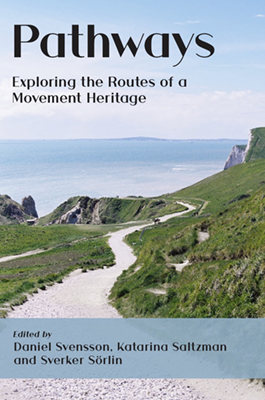Pathways
Exploring the Routes of a Movement Heritage

Edited by Daniel Svensson, Katarina Saltzmann and Sverker Sörlinn
Trails and paths are pathways to the past – and serve as a physical and cultural infrastructure of human memory. While they lead the way forward for anyone out walking, they also point backwards, towards history.
Walking has been a common denominator for human life everywhere, at all times. While other forms of mobility have grown in importance and changed our societies in dramatic ways, most of us still depend on walking in our daily life. The massive number of human steps throughout history has created a rich and widespread network of trails that cross the globe and connect places. It has also resulted in a vast immaterial heritage through literature, art and music about walking. Paths and trails accommodate both the material and the immaterial, and challenge not only conventional heritage management but also the very essence of the nature/culture divide.
In our current age, the Anthropocene, traces of people’s movements can be regarded as a distinct kind of cultural heritage, a ‘movement heritage’ that is dependent on continuous use or memory work to remain. It also points to historical and current forms of land use that is sustainable in the most basic meaning of the word, i.e. that these activities can be and de facto has been practiced over long periods of time without causing large-scale environmental degradation. Few other forms of human mobility can make similar claims.
So, while traces and remains from different kinds of movement may be small in physical scale, they are monumental in terms of their importance for the understanding of how a landscape has been used historically. Traces of mobility form lines that, with Tim Ingold, tie together the life worlds of the past with those of the present.
Walking tracks, paths, and trails are usually ephemeral and often also neglected traces of humans moving by foot through landscapes in the past and the present. These subtle landscape features seem to be difficult to handle within established heritage management regimes, partly because of their fugitive and timid nature. However, their uses and impacts have often been decisive and important for individuals and communities across spatial and temporal scales.
In this anthology, we will explore possibilities to acknowledge human motion, and traces thereof, as heritage. Today, with the increasing interest in local and sustainable connections, and in bodily and spiritual enhancement, we see a growing use of walking tracks both in landscapes within reach from urban centres and in more remotely located or ‘wild’ areas. The corona pandemic has further propelled these trends. Of course, landscapes that are commonly understood as wilderness or ‘nature’ are in most cases clearly influenced by human actions and movements. While walking trails tend to be regarded as pathways to experience nature and as tools to promote public health, they could also be seen and used as routes to culture and history, indeed as pathways to the past. Based on a Swedish research project with the aim to explore the multiple dimensions of walking, paths and movement we will in this volume engage and discuss the potential effects of such an expansion of the heritage register.
Landscapes of mobility have been shaped by hiking, hunting, outdoor life, tourism, sports, and physical training for centuries. They are historical remains of those activities, while simultaneously being the infrastructure for present-day usages. The demand for places suitable for movement, training and events continue to grow, and hiking trails are a key component in the rise of nature-based tourism, sport events such as trail running and mountain biking, and the increasing interest in outdoor life and hiking. So far, the historical and heritage aspects of these developments have been underarticulated. However, the Norwegian heritage board together with the Norwegian Tourist Association (Den Norske Turistforening, DNT) have initiated a project around historical hiking trails that have been attracting attention over the last couple of years. Similar attempts are now being made in Sweden, England, and elsewhere. There is need for a more explicit discussion about trails as heritage. With this anthology we will contribute with precisely that through gathering leading scholars in Europe and beyond around this subject and engaging them in dialogue.
The volume’s objectives include:
- Formulate an expansion of the landscape heritage through one of its most defining practices, movement by foot. This heritage is physical in the shape of paths, trails and effects on vegetation, but it is also a local memory landscape or life world with great significance, and it is increasingly digital as it appears in computer games and mobile images.
- Engage in dialogue around several cases in different regions that show how trails and paths can be, and have been, a resource in and for the heritage sector and for sustainable landscape management
- Analyse how this movement heritage is articulated, and what type of historical, literary, and mediated accounts that are used in the process. It will consist of three sections, tied together through the introduction and the concluding chapter by the editors.
Section two gathers chapters that deal with narrative aspects of walking and trails, through literature, sound and art, often way beyond the beaten track. Two chapters focus on digital walking, in computer games and walking simulators. With the covid-19 pandemic and its effect on our daily routines and possibilities to walk freely, digital walking is a topic in need of more attention.
Section three zooms in on walking and trails as heritage and as tools for sustainable development and demonstrates how paths are also part of an endless co-creation of heritage, as we go.
‘an eye-opening exploration of the different meanings of pathways’
Alice Harvey-Fishenden, Landscape History
Fully Open Access through the support of Gothenburg University and KTH Royal Institute of Technology.
331 pages.
Paperback (ISBN 978-1-912186-55-6) (31st July 2022) £35
eBook (ISBN 978-1-912186-60-0) (published 1st July 2022) OPEN ACCESS
